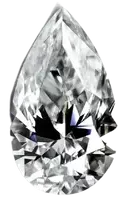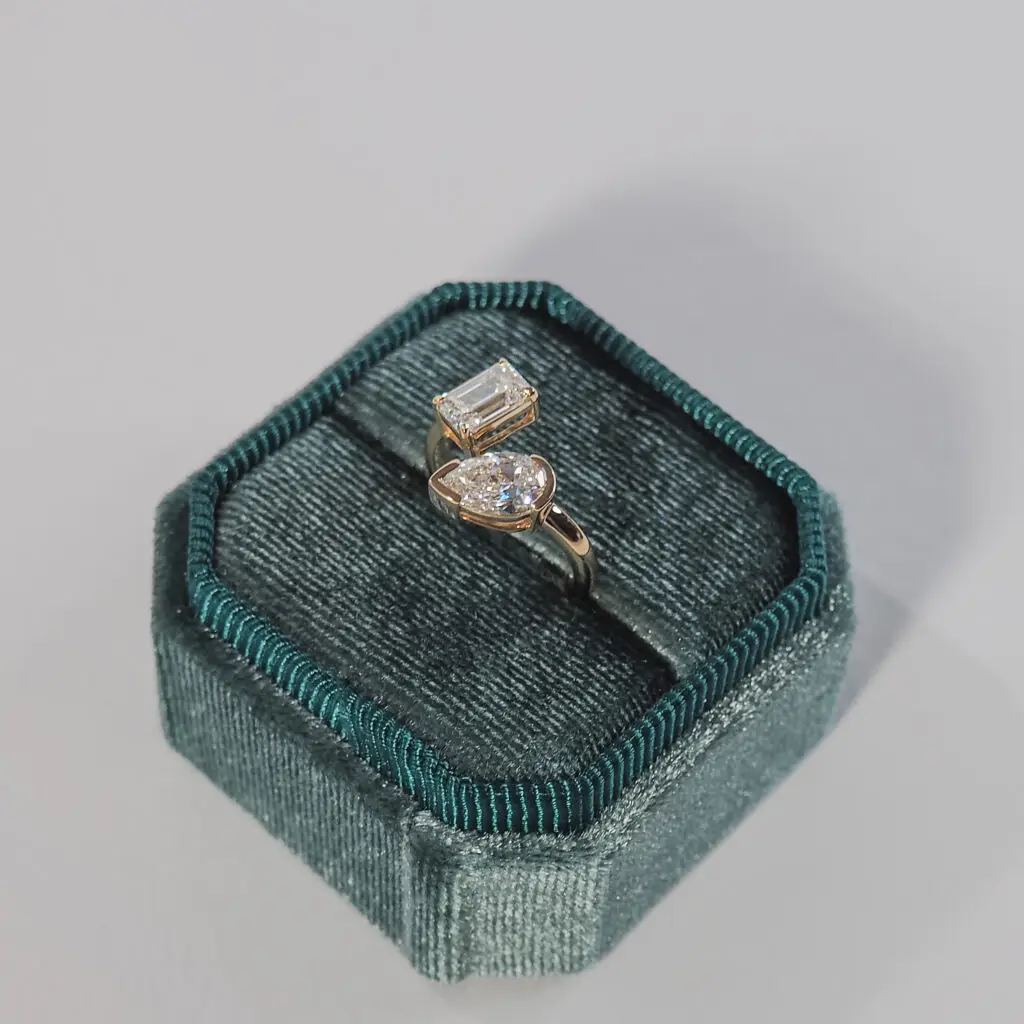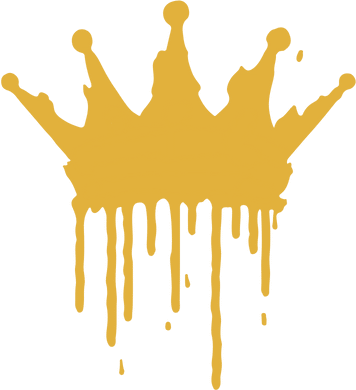 #
#
Gabrielle’s Ideals for Pear Cut Diamonds #
(Table: 56.5–63% (59–62%), Depth: 58–64% (61–64%), Pavilion Depth: 41–45.5%, Pavilion Angle: 40–41.5° (40.2°–41.25°), Crown Angle: 32–36° (33.7°–35.8°), Crown Height: 12–15%, Girdle: 2.5–4.5%)
The pear cut diamond combines the rounded brilliance of a round diamond with the elongated elegance of a marquise, creating a softly tapered silhouette that exudes vintage charm and modern sophistication. Often referred to as the “teardrop” diamond, this shape is known for its versatility, striking brilliance, and slimming effect on the finger.
The pear cut diamond was first developed in 1458 by Flemish diamond cutter Lodewyk van Bercken, who revolutionized diamond cutting by inventing the scaif—a polishing wheel that allowed for precise, symmetrical faceting. The pear shape was one of the first major departures from traditional round diamonds, designed to maximize brilliance while offering a distinctive, elongated silhouette. Over the centuries, the pear cut has remained a symbol of timeless elegance and individuality, favored by those who appreciate both vintage and modern aesthetics.
Pear cut diamonds appear larger per carat than round diamonds due to their elongated proportions. A 1.50-carat pear can face up as large as a 1.75–2.00-carat round, making it an excellent choice for those looking to maximize visual impact without increasing carat weight.
#
1. What Is a Pear Cut Diamond? #
The pear cut diamond features a brilliant-cut facet arrangement, designed for maximum brilliance (white light return), fire (rainbow dispersion), and scintillation (sparkle movement). With a single pointed end and a gracefully curved opposite side, the pear shape combines the best of round and marquise diamonds, making it both refined and unique.
The ideal length-to-width ratio for a pear cut diamond ranges from 1.45–1.75, with 1.50–1.65 being the sweet spot for a well-balanced, symmetrical appearance.
Why Choose a Pear Cut Diamond?
- Elongated & Elegant:
The tapered shape visually elongates the fingers, making it a flattering choice for any hand shape.
- Brilliant-Cut Sparkle:
The faceted structure enhances light return, ensuring maximum brilliance and fire.
- Larger Face-Up Appearance:
A pear cut appears significantly larger per carat than a round diamond of the same weight.
- Versatile Orientation:
Pear diamonds can be set point-up or point-down, allowing for personalized styling.
- Distinctive & Unique:
A pear shape offers a classic yet unconventional look, ideal for those who want something elegant but different from the norm.
Potential Downsides of a Pear Cut Diamond
- Bow-Tie Effect:
Like ovals and marquises, some pear diamonds exhibit a dark bow-tie shadow across the center. While a slight bow-tie can add contrast and depth, an overly pronounced one reduces brilliance.
- Pointed Tip Vulnerability:
The sharp tip of a pear cut is its weakest point, making it susceptible to chipping or damage if not properly protected in a secure setting.
- Proportion Sensitivity:
Achieving optimal brilliance in a pear cut requires carefully balanced proportions. A poorly cut pear can appear too stubby, too long, or unevenly curved.
- Retention of Color & Inclusions:
Pear cuts can trap color in the pointed tip, making lower color grades more noticeable. Similarly, inclusions are more visible in the larger, open facets near the rounded side.
 #
#
2. The 4Cs for a Pear Cut Diamond #
Cut – The Foundation of a Beautiful Pear Diamond
- Table Percentage (IGI: 56.5–63% | Gabrielle’s Ideals: 59–62%)
A well-balanced table ensures even light dispersion while maximizing brilliance.
- Depth Percentage (IGI: 58–64% | Gabrielle’s Ideals: 61–64%)
Depth controls how effectively light reflects back through the table—if too shallow, light escapes; if too deep, the diamond appears dull.
- Pavilion Depth (IGI: 41–45.5%)
Ensures proper light reflection within the diamond, enhancing brightness and contrast.
- Pavilion Angle (IGI: 40–41.5° | Gabrielle’s Ideals: 40.2°–41.25°)
Helps determine light movement and brightness within the stone.
- Crown Angle (IGI: 32–36° | Gabrielle’s Ideals: 33.7°–35.8°)
A steeper crown increases fire, creating a more dynamic, colorful sparkle.
- Crown Height (12–15%) & Girdle (2.5–4.5%)
A properly proportioned crown enhances light dispersion, while a well-balanced girdle ensures durability without excess weight retention.
Pro Tip: A well-cut pear should have a graceful, symmetrical curve and a rounded end—not an overly flat or bulging shape. A balanced table and pavilion depth are essential to avoiding a lopsided or awkwardly proportioned stone.
Color – Enhancing the Brightness
Pear cut diamonds tend to show more color at the pointed tip, so careful selection is important.
- D–F (Colorless): Best for a crisp, icy-white appearance, particularly in platinum or white gold settings.
- G–H (Near Colorless): A great balance of value and whiteness, appearing bright in most lighting conditions.
- I–J: Some warmth may be visible, especially in the pointed tip, but can work well in yellow or rose gold settings.
Pro Tip: If choosing I–J color, consider a setting that masks warmth, such as yellow or rose gold. Otherwise, aim for D–H for a bright, white pear diamond.
Clarity – Choosing Eye-Clean Stones
Because pear diamonds have large open facets near the rounded side, clarity should be carefully evaluated.
- VS1–VS2: The best value—eye-clean with no visible inclusions.
- SI1–SI2: Some SI1 diamonds are eye-clean, but check for inclusions in the center or tip.
- VVS1–VVS2 & Flawless: Nearly flawless, but not necessary unless absolute perfection is a priority.
Pro Tip: Avoid inclusions near the center and tip, as these areas are the most visible.
Carat – Maximizing Size Without Compromising Cut
Pear diamonds appear larger per carat than round brilliants, making them a smart choice for those who want more presence without increasing budget.
Pro Tip: A well-cut 1.50ct pear can face up as large as a 2.00ct round, making it a great option for maximizing visual size.
3. Additional Considerations #
Symmetry & Polish
- Symmetry: Choose an “excellent,” cut to get a well-cut pear with even curvature on both sides, avoiding flat areas or an off-center point.
- Polish: Affects facet crispness and overall light return—aim for Excellent or Very Good polish.
Fluorescence
- None or Faint fluorescence is ideal, as strong fluorescence may cause haziness in some lighting conditions.
Certification
- Always buy IGI- or GIA-certified diamonds to ensure accurate grading.
Setting Considerations
- Protect the pointed tip! A prong or bezel setting is essential for durability.
- Metal Choice:
- Platinum/white gold enhances brightness.
- Yellow/rose gold can soften warmth in H–J color diamonds.
#
Final Thoughts #
A well-cut pear diamond is both timeless and uniquely elegant. With superior brilliance, a distinctive shape, and incredible finger coverage, it’s an excellent choice for those who want maximum sparkle with an unconventional twist.
By following Gabrielle’s Ideals, you can confidently select a pear cut diamond that is balanced, high-performing, and visually stunning.
Happy diamond hunting—may your pear diamond be as luminous and elegant as you are!


